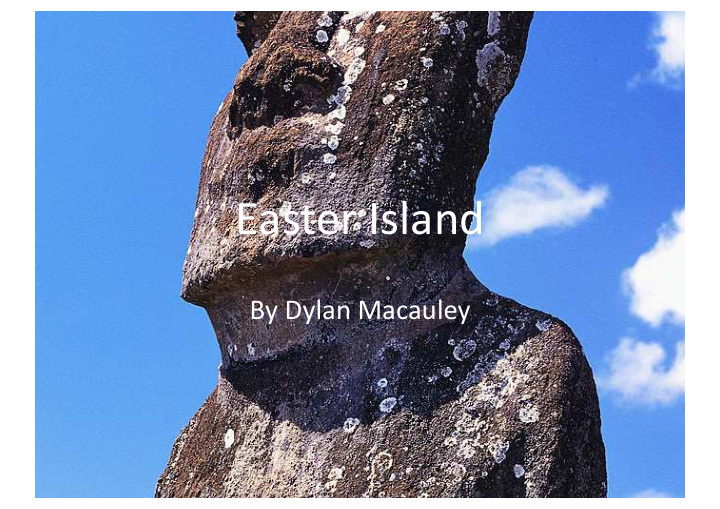



Easter ¡Island ¡ By ¡Dylan ¡Macauley ¡
The ¡Moai ¡(the ¡heads) ¡ • monolithic ¡human ¡figures ¡carved ¡from ¡rock ¡on ¡the ¡Chilean ¡ Polynesian ¡island ¡of ¡Easter ¡Island ¡between ¡the ¡years ¡1250 ¡ and ¡1500. ¡ • Nearly ¡half ¡are ¡sHll ¡at ¡Rano ¡Raraku, ¡the ¡main ¡moai ¡quarry, ¡ but ¡hundreds ¡were ¡transported ¡from ¡there ¡and ¡set ¡on ¡ stone ¡plaMorms ¡called ¡ahu ¡around ¡the ¡island's ¡perimeter. ¡ • The ¡tallest ¡moai ¡erected, ¡called ¡Paro, ¡was ¡almost ¡10 ¡ metres ¡(33 ¡P) ¡high ¡and ¡weighed ¡82 ¡tons, ¡the ¡heaviest ¡ erected ¡was ¡a ¡shorter ¡but ¡squaRer ¡moai ¡at ¡Ahu ¡Tongariki, ¡ weighing ¡86 ¡tons ¡and ¡one ¡unfinished ¡sculpture, ¡if ¡ completed, ¡would ¡have ¡been ¡approximately ¡21 ¡metres ¡(69 ¡ P) ¡tall ¡with ¡a ¡weight ¡of ¡about ¡270 ¡tons ¡
The ¡Plants ¡ At ¡the ¡Hme ¡of ¡European ¡arrival ¡the ¡toromiro ¡tree, ¡endemic ¡to ¡the ¡island, ¡ • was ¡the ¡only ¡wild ¡tree ¡and ¡the ¡Carolina ¡wolXerry ¡the ¡only ¡wild ¡shrub. ¡ The ¡toromiro ¡tree ¡was ¡overexploited ¡by ¡the ¡island ¡wood ¡carvers, ¡and ¡the ¡ • last ¡local ¡specimen ¡died ¡in ¡the ¡1950s. ¡The ¡species ¡was ¡saved ¡from ¡ exHncHon, ¡however; ¡the ¡Norwegian ¡Archaeological ¡ExpediHon. ¡ Analysis ¡of ¡pollen ¡deposits ¡has ¡revealed ¡that ¡other ¡trees ¡and ¡shrubs, ¡ • among ¡them ¡the ¡giant ¡Chile ¡palm ¡(Jubaea ¡spectabilis), ¡were ¡formerly ¡ present ¡on ¡the ¡island ¡unHl ¡exterminated ¡by ¡extensive ¡fires ¡occurring ¡at ¡the ¡ Hme ¡of ¡aboriginal ¡human ¡seRlement. ¡Today ¡only ¡31 ¡wild ¡flowering ¡plants, ¡ 14 ¡ferns, ¡and ¡14 ¡mosses ¡are ¡reported. ¡Grass ¡and ¡small ¡ferns ¡dominate ¡the ¡ barren ¡landscape, ¡whereas ¡the ¡boggy ¡crater ¡lakes ¡are ¡thickly ¡covered ¡by ¡ two ¡imported ¡American ¡species, ¡the ¡totora ¡reed ¡(an ¡important ¡building ¡ material) ¡and ¡Polygonum ¡acuminatum ¡(a ¡medicinal ¡plant). ¡A ¡number ¡of ¡ culHvated ¡species ¡of ¡plants ¡were ¡also ¡introduced ¡partly ¡from ¡America ¡and ¡ partly ¡from ¡Polynesia ¡before ¡the ¡arrival ¡of ¡Europeans ¡
The ¡Wildlife ¡ ¡ • Before ¡the ¡arrival ¡of ¡human ¡beings, ¡the ¡only ¡vertebrates ¡were ¡ either ¡fish ¡or ¡seabirds ¡capable ¡of ¡long ¡flights. ¡The ¡animal ¡life ¡on ¡ land ¡was ¡otherwise ¡restricted ¡to ¡a ¡very ¡few ¡species ¡of ¡spiders, ¡ insects, ¡worms, ¡a ¡snail, ¡and ¡a ¡cenHpede. ¡Vast ¡quanHHes ¡of ¡flies, ¡ large ¡cockroaches, ¡and ¡a ¡small ¡scorpion ¡were ¡introduced ¡recently. ¡ • The ¡aboriginal ¡edible ¡Polynesian ¡rat ¡was ¡subsequently ¡replaced ¡by ¡ larger ¡European ¡species. ¡Sheep, ¡horses, ¡caRle, ¡and ¡pigs ¡were ¡ introduced ¡by ¡the ¡missionaries ¡who ¡established ¡themselves ¡ashore ¡ in ¡1864. ¡ • A ¡large ¡wild ¡cat, ¡living ¡in ¡caves, ¡is ¡of ¡unknown ¡introducHon. ¡A ¡ Chilean ¡partridge, ¡a ¡quail, ¡and ¡a ¡small ¡hawk ¡have ¡been ¡added ¡to ¡the ¡ wildlife ¡since ¡1880. ¡Sea ¡turtles ¡and ¡seals ¡are ¡now ¡rare ¡curiosiHes, ¡ but ¡crayfish ¡and ¡various ¡coastal ¡and ¡deep-‑sea ¡fishes ¡abound ¡around ¡ the ¡coast. ¡
The ¡End ¡
Recommend
More recommend